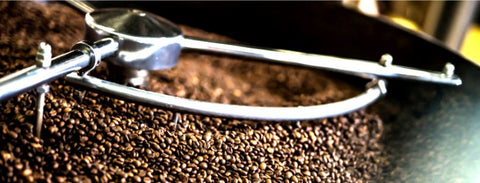Coffee beans from different regions of the world present different characteristics of sweetness, acidity and even aroma, though in their fresh, newly harvested state our noses may not be sensitive enough to pick up on the aromatic nuances of the fruit. For us, the experience and pleasure of good coffee flavor and aroma is attainable through roasting. And it is not as simple as that.
Only the right progression of roasting stages adds up to the release of coffee’s most amiable flavor and aroma attributes. In fact, without the aromatic attributes of coffee, we probably would not enjoy our java nearly as much as we do, if at all. Coffee roasting releases more than just flavor and aroma. Heat produces chemical reactions that transform coffee’s acidity, body and even its aftertaste.
Here are the 5 Stages of Roasting that, when precisely applied, release the best qualities in a coffee lover’s cup. The process begins around 150°C/302°F and concludes as temperatures increase to reach 230°C/446°F.
1) The Maillard Reaction – This is the very same process that is responsible for our love of perfectly toasted bread. It is a heat-induced reaction between amino acids and sugars that produced browning in some foods and gives distinctive color and flavor to coffee. The Maillard Reaction releases not merely a few, but hundreds of flavor compounds from green coffee beans.
2) Caramelization – The Maillard reaction evolves into caramelization whereby the sugars present in coffee beans convert to caramelized compounds. By now the beans have turned to a light brown. This is a critical point in the roasting process, as the bitter-tasting attributes degrade at this stage. The Maillard reaction and caramelization stages overlap and conclude with the next roasting stage known as “the First Crack.”
3) The First Crack – As water vaporizes inside the bean, pressure increases and finally gives way with an audible cracking sound from the bean walls. The bean has now expanded to double its original size and lost some of its water content. This marks the “Light Roast” point, but further richness of flavor and aroma are to be attained at higher temperatures.
4) Pyrolysis – Carbon dioxide is released from the bean as it reaches higher temperatures. It loses about 13% of its weight at this time and its color darkens to a medium brown.
5) The Second Crack – The “deconstruction” of the bean brought about by pyrolysis continues with temperatures reaching 230°C/446°F. The cellulose in the bean walls gives way and breaks apart, audibly. This is the ultimate roasting stage where the most desirable flavor and aroma compounds are released in a visible sheen covering each coffee bean. The color is now a rich, dark brown.
Good quality coffee is bagged and shipped immediately after this process to ensure the highest freshness of taste once brewed.





Comments (0)
There are no comments for this article. Be the first one to leave a message!